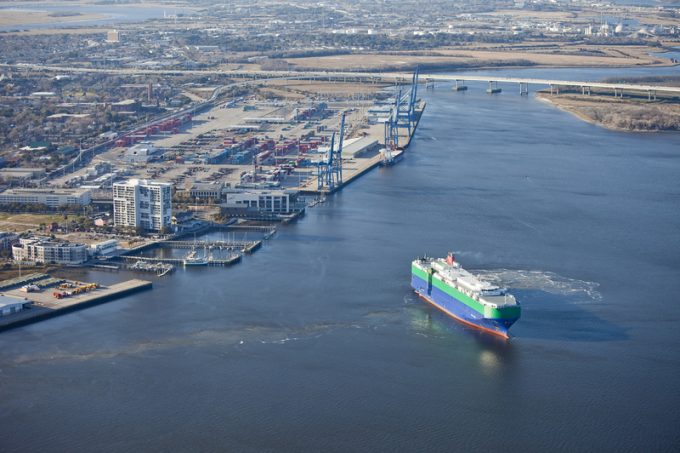US East and Gulf Coast dockers ready to 'hit the streets' in 80 days
US East and Gulf Coast port workers are prepared to “hit the streets” on 1 ...
TFII: SOLID AS USUALMAERSK: WEAKENINGF: FALLING OFF A CLIFFAAPL: 'BOTTLENECK IN MAINLAND CHINA'AAPL: CHINA TRENDSDHL: GROWTH CAPEXR: ANOTHER SOLID DELIVERYMFT: HERE COMES THE FALLDSV: LOOK AT SCHENKER PERFORMANCEUPS: A WAVE OF DOWNGRADES DSV: BARGAIN BINKNX: EARNINGS OUTODFL: RISING AND FALLING AND THEN RISING
TFII: SOLID AS USUALMAERSK: WEAKENINGF: FALLING OFF A CLIFFAAPL: 'BOTTLENECK IN MAINLAND CHINA'AAPL: CHINA TRENDSDHL: GROWTH CAPEXR: ANOTHER SOLID DELIVERYMFT: HERE COMES THE FALLDSV: LOOK AT SCHENKER PERFORMANCEUPS: A WAVE OF DOWNGRADES DSV: BARGAIN BINKNX: EARNINGS OUTODFL: RISING AND FALLING AND THEN RISING

Following yesterday’s news that negotiations between US west coast terminal operators and dockers had reached agreement on some issues, the International Longshoremen & Warehouse Union and the Pacific Maritime Association broke their silence to reassure industry stakeholders that talks were continuing.
They emphasised that the long process (negotiations to renew the labour contract began last May) had not disrupted port operations and expressed hope of “reaching a deal soon”.
However, stakeholders have shown impatience, warning it could result in permanent loss of cargo flowing through the west coast ports, which likely impelled the two sides to speak.
They said a tentative deal had been reached on “certain key issues, including health benefits”, and expressed their commitment to resolve the other points “as expeditiously as possible”.
But observers are not convinced this will happen soon. One industry executive said no progress had been made on the critical issue of automation, nor on the controversy over cold ironing at the port of Seattle that derailed talks for months.
The glacial pace also raises concerns about contract talks on the east coast, where the master contract between union International Longshoremen’s Association (ILA) and the US Maritime Alliance (USMX), which represents ocean carriers and terminals, is set to expire next year.
On top of familiar issues like automation, pay and benefits, there is the dispute over work allocation at Charleston’s Leatherman terminal, which has affected operations at the South Carolina port. Since the $1bn terminal opened in 2021, the ILA and Ports South Carolina have been in dispute.
The bone of contention is who is eligible to operate cranes and lift equipment. The ILA argues this has to be performed by union members, in line with the master contract for all east and Gulf coast ports. SC Ports maintains it is not party to that agreement and has a long-standing policy under which non-union state employees work cranes and lift equipment, while ILA members perform all other jobs.
“Each side believes its position is right,” commented an industry executive close to the situation, which has escalated into a legal battle.
The port has enjoyed strong growth, which boosted its throughput to 2.8m teu last year, and it has invested a lot of money to accommodate further growth. Last summer, it strengthened the wharf, brought in taller cranes and improved the container yard at the Waldo Welch container terminal, broke ground on an intermodal facility with a capacity of one million rail lifts in phase one and launched a pool of 13,000 chassis. It has also invested in deepening the harbour to 16 metres.
It is expected that the Leatherman dispute will be on the table in the ILA-USMX contract negotiations, and some stakeholders hope the talks will resolve the issue, sparing everybody a lengthy legal battle that could go all the way to the Supreme Court.
On the other hand, there is concern the issue will complicate the contract negotiations and delay any agreement.
But even without an additional stumbling block, the talks should be challenging – although both sides have expressed “mutual respect and willingness to find a compromise”.
“There are big issues on the table,” said one observer, pointing to the thorny issue of automation. “Ports need the ability to handle more cargo without building new facilities.”
The dispute has caused one move at Charleston so far: At the end of last month, Hapag-Lloyd announced it was shifting its calls to the Wando Welch terminal, after, according to some sources, experiencing some fallout from the situation in Charleston at other US ports.
Comment on this article